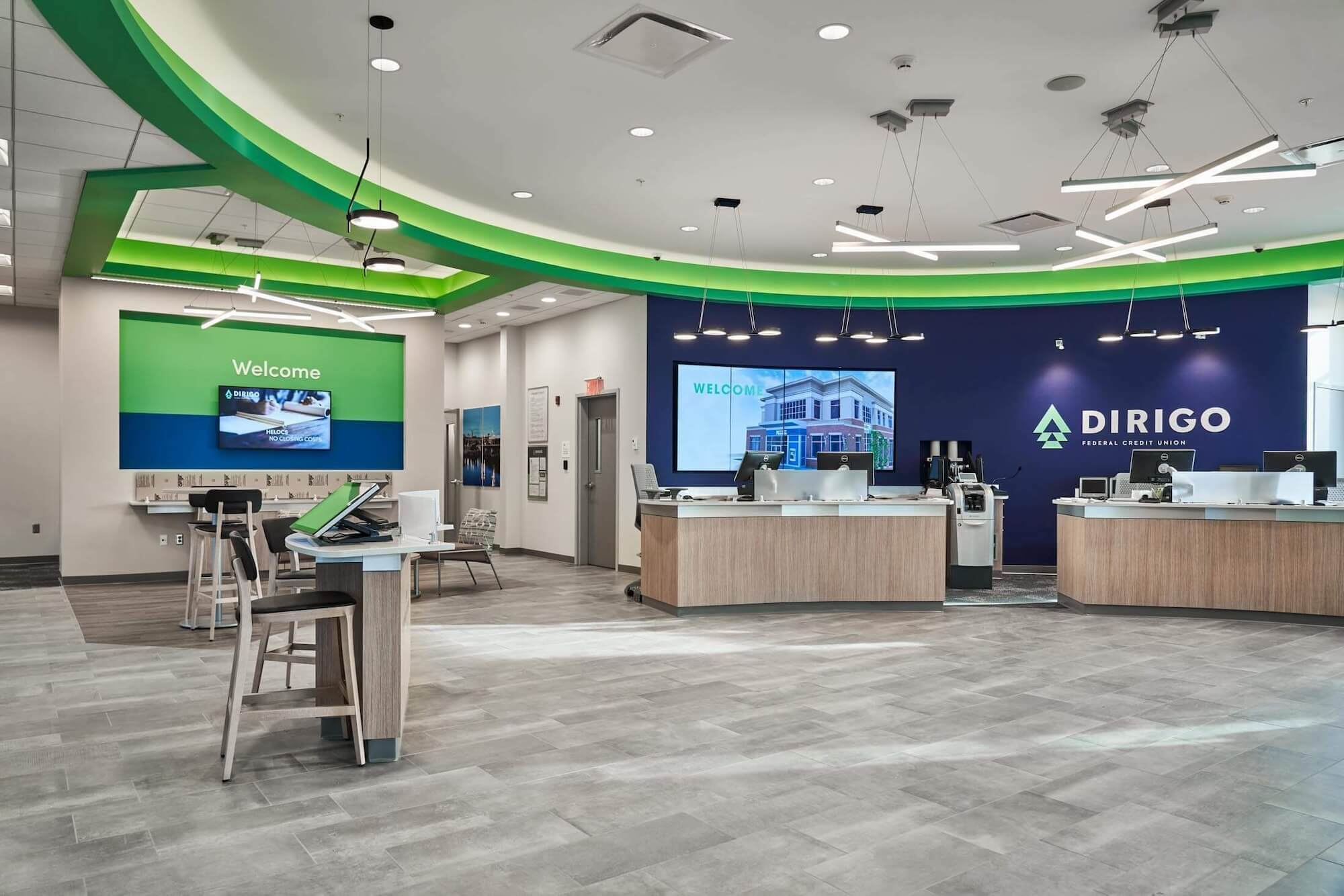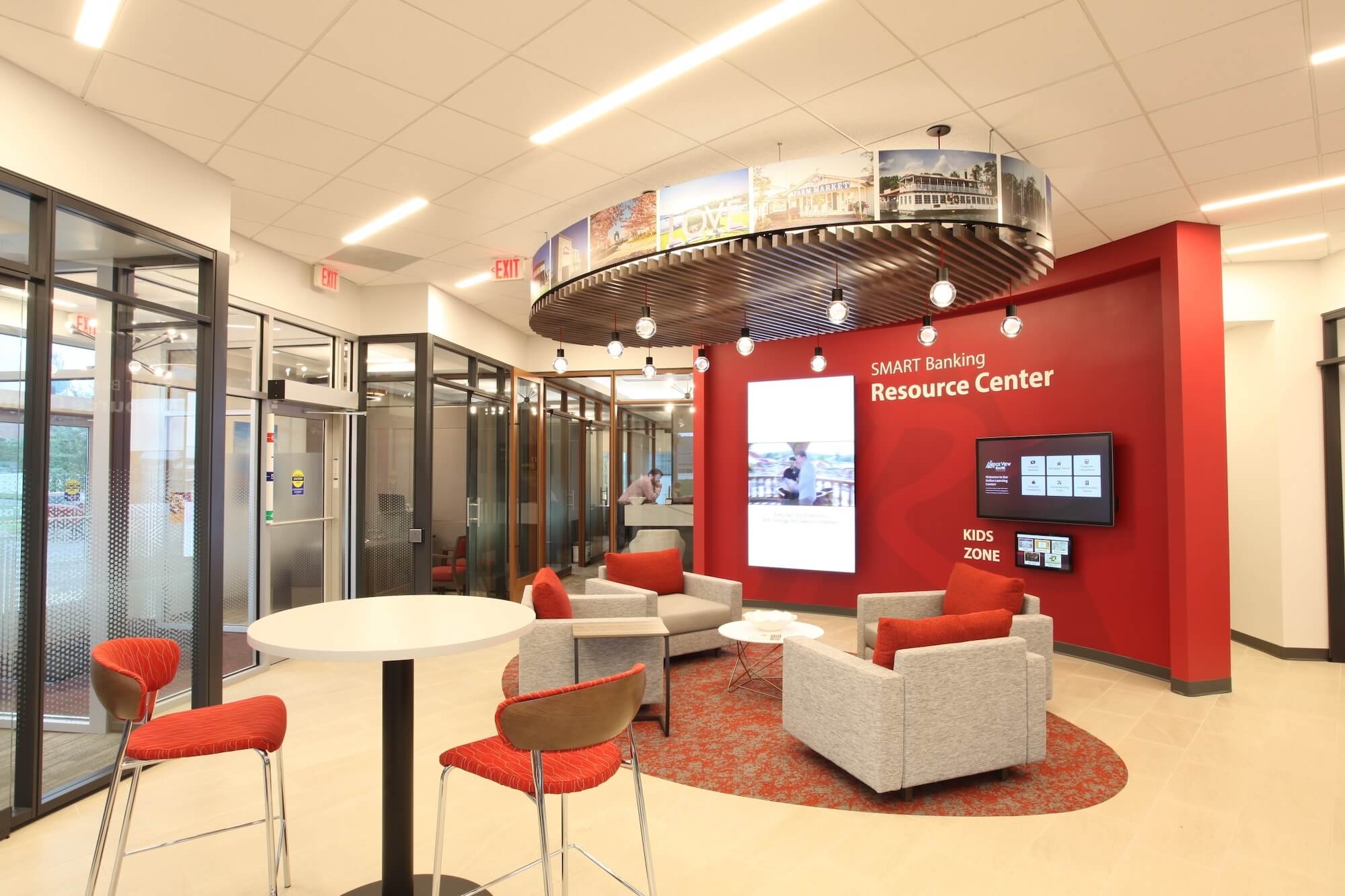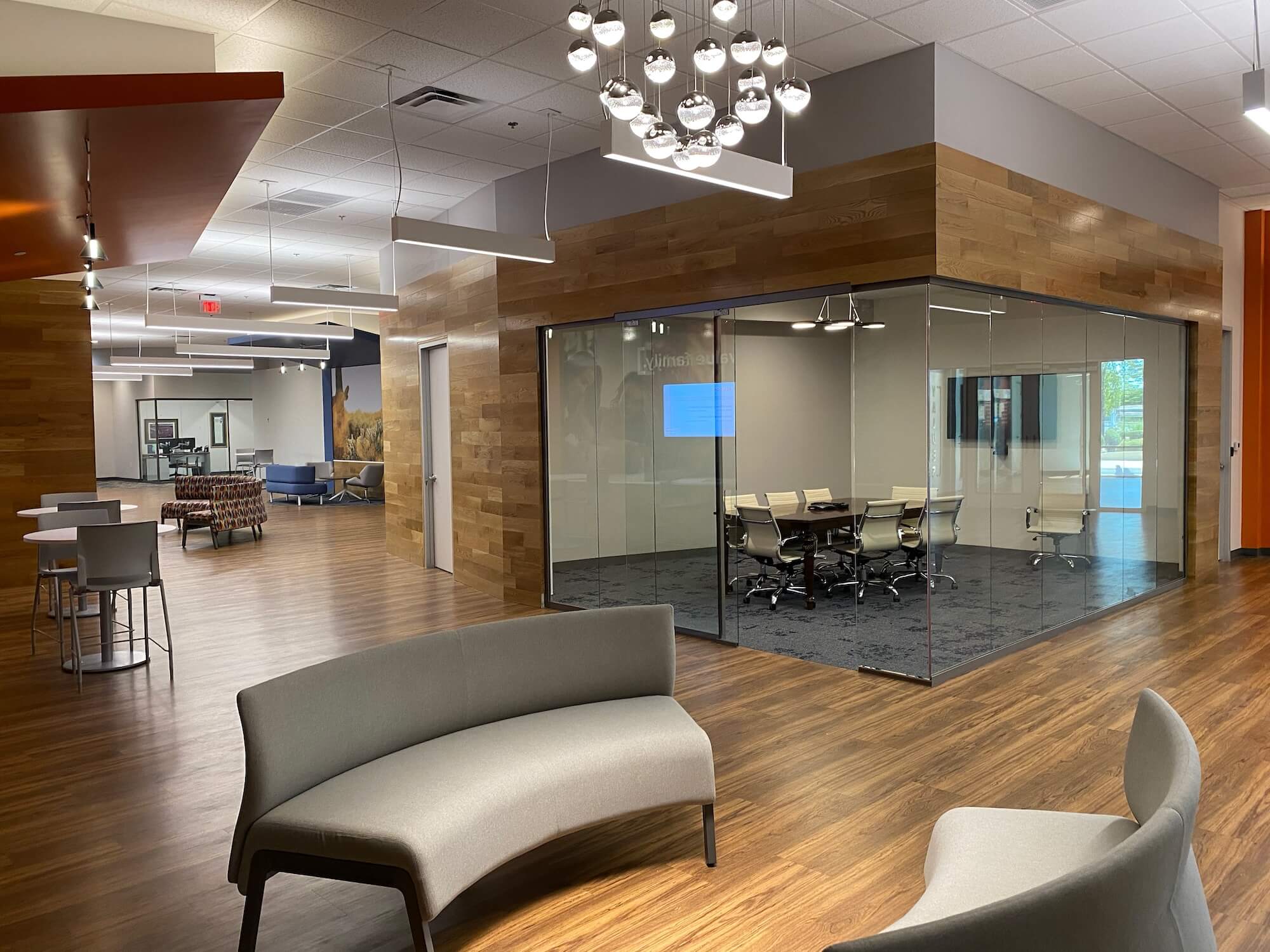Physical financial branches play a critical role in consumer engagement, with 86% of customers globally visiting a branch in the past year and 45% making monthly visits. In 2024, credit union and bank interior design is more important than ever as financial institutions seek to create spaces that are not only functional, but also inviting and community-focused.
Today’s interior banking trends — from smaller, more agile branches to the use of bold colors and natural light — are shaping how banks and credit unions connect with their customers and members. Here are the top 10 trends that can transform your branch into a dynamic and engaging environment.
the value of the physical branch
Physical branches are a cornerstone of customer engagement, offering a space where meaningful, face-to-face interactions can occur. These environments foster trust, provide expert advice, and nurture lasting relationships.
Thoughtful interior design enhances these experiences, creating inviting spaces that make customers and members feel welcome and appreciated. Whether it’s a well-placed seating area for private consultations or an open layout that encourages exploration, the design of your credit union or bank interior can significantly impact how members and customers perceive and interact with your institution.
top 10 credit union and bank interior design trends
Branch design is adapting to meet changing customer expectations and the evolving role of financial institutions in their communities. Here are 10 interior design trends making an impact:
Trend 1: Smaller Branches
Financial institutions are opting for smaller, more efficient branches. These compact spaces reduce overhead costs by requiring less real estate while strategically placing banks in emerging markets. In these smaller branches, the focus shifts to personalized service, where staff know customers and members by name, and the intimate setting fosters deeper relationships. The design often includes cozy, private meeting areas and flexible spaces that can adapt to the needs of different customers throughout the day.
Trend 2: Open, Flexible Floor Plans
To promote transparency and accessibility, open-concept designs — which remove physical barriers such as walls and partitions — are becoming the norm. These layouts encourage natural movement, with transactional devices seamlessly integrated into the open environment, making interactions easier and more intuitive. Additionally, it provides flexibility for potential future reconfiguration of spaces.
Trend 3: Technology Integration
Branches are integrating tech-based elements such as interactive kiosks, digital signage, and remote delivery channels such as ITMs (Interactive Teller Machines) and Smart ATMs. These technologies act as transactional tellers, streamlining services while offering customers a flexible and convenient banking experience and freeing up employees to focus on consultative interactions. Whether checking in at a digital kiosk, engaging with a virtual teller, or using an ITM for quick transactions, customers can access services at their own pace, reducing wait times and enhancing overall efficiency.
Trend 4: Consultation-Centric Design
Designing branches with consultation in mind means creating spaces that function more like a comfortable living room than a traditional bank. Picture plush chairs arranged in a semi-circle around a low table, with soft lighting that makes the space inviting. These areas are flexible and can accommodate one-on-one financial advice sessions or small group consultations. Inspired by the hospitality industry, these spaces encourage customers or members to sit down, relax, and have meaningful conversations that go beyond routine transactions.
Trend 5: Teller Pods and Erasing Physical Barriers
The traditional teller line is giving way to teller pods and stations, which reduce physical barriers and promote a more open, trust-building environment. Instead of standing across a counter, customers interact with tellers at pods designed for sitting or standing, making exchanges feel more like personal interactions than business transactions. These pods are often positioned throughout the branch, enabling customers or members to receive assistance wherever they are most comfortable.
Trend 6: Intuitive Wayfinding
Modern financial branches use environmental graphic elements to guide customers through the space. By integrating branded colors, textures, and imagery into the design, different areas within the branch are naturally defined. This approach enhances branding and promotes products and services without the need for excessive signs. Customers navigate intuitively, engaging with the environment in a way that feels seamless and personalized, all while the branch’s aesthetic reinforces the institution’s identity and values.
Trend 7: Multi-Functional Spaces
Branches now serve multiple purposes- transforming traditional banking environments into community hubs. Conference rooms double as event spaces for local businesses or educational seminars, while coffee bars invite customers or members to linger, perhaps catching up on work using the branch’s free Wi-Fi. Coworking stations with charging ports and comfortable seating offer a space for freelancers or business travelers, attracting more visitors and promoting a positive brand.
Trend 8: Hypermodern Look with Geometric Shapes
Some designers are leaning toward a hypermodern aesthetic, incorporating geometric shapes into every aspect of the branch — from the angles of the walls to the patterns on the flooring. Scandinavian-style desks with clean, angular lines provide a minimalist workspace for staff, while geometric lighting fixtures add a contemporary flair. This sleek, uncluttered design appeals to the modern customer and reinforces the bank’s commitment to forward-thinking and innovation.
Trend 9: Bold Colors and High Ceilings
Bold, vibrant colors paired with high ceilings create an optimistic and inviting atmosphere. The use of deep blues or vibrant greens can energize the space, while high ceilings give the branch an airy, open feel. This design approach makes the branch seem more spacious and uplifting, creating a positive environment that influences the mood and energy levels of everyone who walks through the door.
Trend 10: Natural Lighting
Maximizing natural light remains a key trend, as it creates a warm, welcoming environment. Large windows and strategically placed skylights flood the branch with sunlight, reducing the need for artificial lighting and connecting with the outside environment. Natural light enhances the colors and materials used in the branch’s design, making the space more alive and inviting, while also contributing to the well-being of customers and staff alike.
addressing customer and member needs through interior design
Meeting customer and member needs is central to the success of any branch, and interior design plays a crucial role in achieving this. The trends we’ve explored are more than just aesthetic choices — they are strategic responses to evolving expectations.
Comfort and Accessibility
For instance, the trend toward smaller branches focuses on creating intimate environments that make customers and members feel valued and comfortable. Open floor plans enhance accessibility, allowing for smooth navigation and encouraging interaction between staff and customers.
User-Friendly Design
User-friendly design minimizes friction points, as seen in the emphasis on intuitive wayfinding. By integrating clear signage and logical layouts, branches ensure customers can easily access the services they need without confusion.
Personalized Experiences
Trends such as consultation-centric design and multi-functional spaces directly address the demand for personalized and versatile experiences. These design elements transform branches into spaces where customers and members feel understood and catered to, fostering stronger relationships.
creating a community feel with interior design
Several of the top trends we’ve discussed share a common goal: boosting the sense of community within banks and credit unions. By fostering environments where customers or members can connect with each other or with agents, these trends lay the foundation for a welcoming branch experience. Additional design elements take this sense of community even further, transforming your branch into a true community hub.
Biophilic Design
The emphasis on natural lighting can be complemented by incorporating plants and green spaces. This not only enhances the aesthetic appeal but also creates a calming, inviting atmosphere that resonates with customers.
Local Art and Design Elements
Incorporating local culture through art and materials that reflect the community’s character adds a personal touch to the branch. This approach can enhance trends such as the hypermodern geometric pattern look, making the branch part of the community rather than just a place of business.
Exterior Design and Layout
Extending the idea of multi-functional spaces to the outdoors can encourage community interaction even before customers step inside. Thoughtfully designed outdoor areas, such as landscaped pathways and seating, create a seamless connection between the branch and its surroundings.
transforming branches with credit union and bank interior design
Thoughtful branch design can transform your institution into a vibrant community hub, fostering deeper connections with customers and members. By embracing these strategies, you can create spaces that reflect your commitment to the people you serve.
Ready to bring these ideas to life? Contact The Element Group for a consultation, and explore more insights in our webinar on the future of retail banking.




